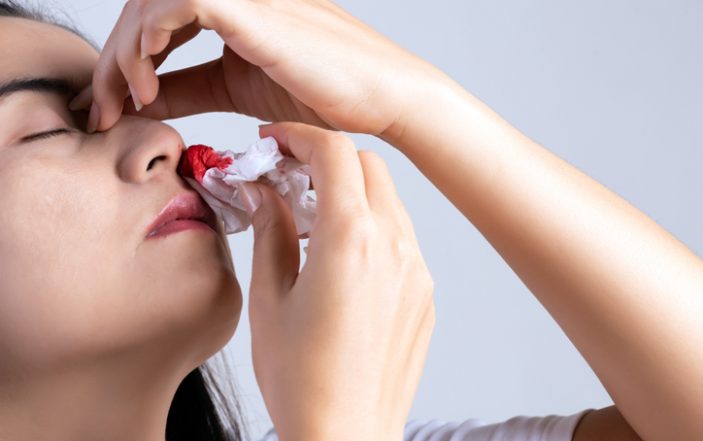The NoPAC Trial: Gauging the measure of effectiveness in epistaxis.
Epistaxis is a common complaint seen in the emergency department. Standard care involves holding pressure, use of local vasoconstrictors, topical application of silver nitrate, cautery and if all else fails, anterior nasal packing.
This final step is even more common in patients who are taking antiplatelet agents or anticoagulants. In recent years, tranexamic acid (TXA) has been added to many physicians’ armamentarium based on small studies. While topical TXA has minimal safety concerns and is relatively inexpensive, higher quality studies are needed to further evaluate this treatment approach. Enter the NoPAC trial.
This was a randomized, double-blind, parallel-group, placebo-controlled trial in 26 centers in the UK. Patients were randomized to TXA 200mg in 4mL applied to a cotton wool dental roll (this could be repeated x1) or a cotton wool dental roll soaked in sterile water. In both cases the dental roll was held in place for 10 minutes with pressure.
The primary outcome of the trial was use of anterior nasal packing (of any kind) during the index ED visit regardless of any other additional treatments. Additional secondary outcomes of note included need for blood transfusion, recurrent epistaxis and thrombotic events.
A total of 496 patients were randomized and the number of patients requiring anterior packing was 41.3% for placebo and 43.7% for topical TXA (no statistical difference). As for the secondary outcomes, there was also no major statistical difference in any of the secondary outcomes. Patients on anticoagulation were also evaluated and again, no difference between placebo (68.6%) vs topical TXA (61%).
This is the largest study to investigate the role of topical intranasal TXA as an adjunct to standard therapy. It is methodologically sound with double blinding and appropriately performed randomization. Most importantly the study asks a clinically relevant question with a patient centered outcome (anterior nasal packing hurts).
Prior studies have used higher doses (500mg) of TXA. However, it is unclear if the larger amount of TXA that the applicator was soaked in would result in a larger amount of TXA reaching the mucosal tissue or would just simply cause wasted TXA.
A key point of this study is that it did not investigate all-comers with epistaxis. All patients had local pressure applied followed by topical vasoconstrictor (phenylephrine) prior to receiving either TXA or placebo.
It was only after failure of simple first aid (i.e. direct pressure) and application of topical vasoconstrictor that patients were enrolled in the study. In the US, the most common vasoconstrictor is oxymetazoline. It is unclear if one agent is superior to the other.
Some may read this trial and see a ≈44% admission rate, which is quite high, and not reflective of care in other countries like the US. Discussion with the authors reveals that this is likely due to the UK “four-hour rule,” in which patients must be dispositioned by four hours and thus in 44% of cases required admission.
So how is it that this trial seems to differ from previous evidence showing benefit?
- The previous trials are randomized, but unblinded. Unblinding can bias outcomes. If you believe TXA works and you know when you are giving it or not, giving this will potentially alter outcomes in favor of TXA.
- It is also unclear in prior studies what care was provided prior to the intervention of TXA. Maybe something given prior to TXA is what actually got the bleeding to stop and not the TXA itself.
- Previous evidence comes from small trials, which can often overestimate benefit due to small numbers of patients.
Ultimately this is the largest and most methodologically rigorous study to date on the use of topical TXA in epistaxis. When considering all the literature, this study definitely swings the pendulum towards advising against routine use. However, it is not clear based on all the available evidence exactly what is the best approach leaving ample room for clinical preference.
References:
- Reuben A et al. The Use of Tranexamic Acid to Reduce the Need for Nasal Packing in Epistaxis (NoPAC): Randomized Controlled Trial. Ann Emerg Med 2021. PMID: 30772866



